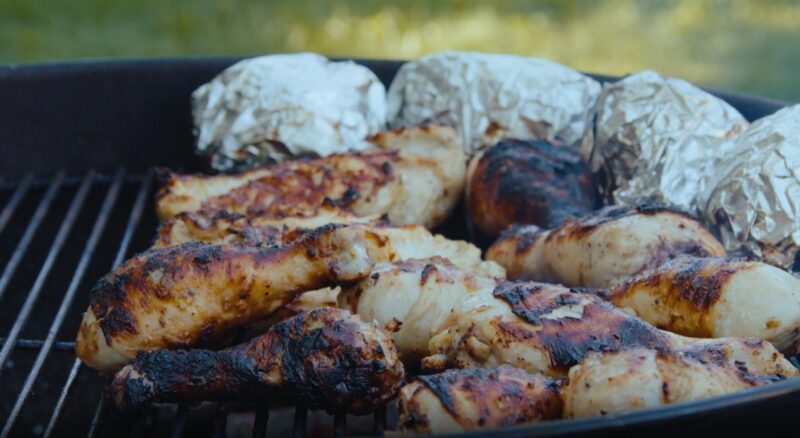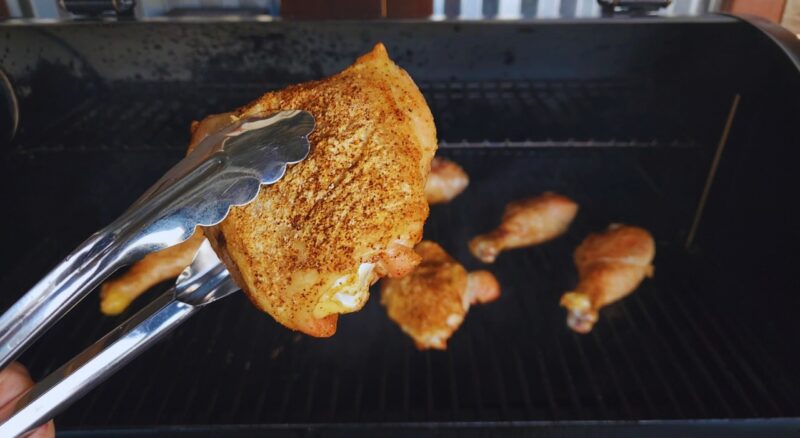When you take the time and effort to smoke a chicken, you expect perfection. The anticipation of that mouth-watering smoky flavor is real. However, when you slice through the meat and get a bite of rubbery skin, the disappointment is palpable. The good news? Rubbery skin on smoked chicken is preventable. Here’s how.
The Basics
When smoking chicken, the skin often turns out less than ideal. It’s not the smoke or the seasoning—it’s the science of cooking. So, before we dive into solutions, it’s crucial to comprehend the cause.
The Role of Collagen
Collagen is a protein found in chicken skin. When cooked slowly, as in smoking, the collagen doesn’t break down effectively. Instead, it forms a barrier that traps moisture, leading to that rubbery texture we all despise.
Smoking requires patience
The slow process ensures deep flavors but also poses a challenge for the skin. Collagen needs a higher temperature to break down and render fat. With the average smoker operating between 225°F and 250°F, it’s not hot enough for the skin to crisp.
The Moisture Dilemma
Moisture is the enemy of crispness. As the chicken smokes, its skin retains water, making it challenging to achieve the desired crispy exterior.
The Smoker’s Environment Plays a Role
Unlike ovens or grills, smokers are in a moisture-rich environment. The water pan in most smokers keeps the cooking chamber humid, preventing the meat from drying out but also making it difficult for the skin to dry and crisp up.
Steps to Achieve Crispy Skin

Now that you understand the culprits, it’s time to address them. Let’s explore actionable solutions to ensure you get that coveted crispy skin on your smoked chicken.
Proper Prepping of The Chicken
Begin by addressing the chicken skin’s moisture. One effective method is air-drying the chicken. After washing and seasoning, place the chicken on a rack in the refrigerator, uncovered, for several hours or overnight.
Patience pays off. The cold air in the fridge dries out the skin, reducing the moisture content. This preparation step is a game-changer for achieving the crispness you desire.
Tweaking Your Smoking Technique
While you can’t change the collagen content in chicken, you can modify your cooking technique. Consider increasing your smoker’s temperature. By raising the temperature to around 275°F to 300°F, you facilitate the rendering of fat and the breaking down of collagen.
It’s About Balance
Higher temperatures may speed up the cooking process, so monitor your chicken’s internal temperature. Ensure it reaches a safe 165°F in the thickest part without overcooking.
Post-Smoking Crisping
If you’ve smoked your chicken and the skin isn’t as crispy as you’d like, all hope isn’t lost. Remove the chicken from the smoker once it’s cooked, and give it a quick sear on a hot grill or under a broiler. Choosing the right grill can also make a difference. Before you buy one, it is useful to learn more about some details like the main features, maintenance, running costs, and more.
Watch Closely
This step is quick and only requires a few minutes. You’re simply crisping the skin, so ensure you don’t char or overcook the meat underneath.
Enhancing the Flavor Profile

Apart from the texture of the skin, the flavor of your smoked chicken is paramount. A crispy skin that’s bland or overly salty can ruin the entire experience. Let’s delve into how you can enrich the taste while working towards that crispy perfection.
Brining is Key
Brining is the process of soaking the chicken in a saltwater solution, sometimes with added sugar, spices, and herbs. This not only enhances the flavor but also helps retain moisture in the meat, making it juicy and tender.
The Science Behind It
Brining alters the protein structures in the chicken, allowing it to retain more water. But remember, the goal is moist meat and crispy skin. So, after brining, ensure you dry the chicken thoroughly, especially the skin, before smoking.
Choosing the Right Wood
The wood you choose for smoking directly impacts the flavor profile of your chicken. Fruitwoods like apple and cherry give a milder, sweeter taste, while hickory and mesquite impart a stronger, more robust flavor.
Experiment and find your blend: Don’t hesitate to mix woods. A combination of apple and hickory, for instance, can provide a balanced smokiness with a hint of sweetness.
Herbs and Spices Under the Skin
An excellent way to boost flavor is by placing herbs and spices directly under the chicken skin. This not only seasons the meat but also helps separate the skin from the meat, aiding in rendering the fat for a crispier finish.
Be Adventurous With Your Flavor Choices
Fresh herbs like rosemary, thyme, and garlic can work wonders. Rubs with paprika, cayenne, or even a touch of brown sugar can elevate the taste to the next level.
Consistency is King
Perfecting the art of smoked chicken requires consistent practice. It’s not just about preventing rubbery skin but ensuring every bite is an explosion of flavor and texture that delights the senses.
Keep Notes
Every chicken, smoker, and wood type can behave differently. Keeping a smoking journal where you jot down temperatures, cooking times, wood types, and outcomes can help you refine your technique over time.
Learning from the past: By reviewing your notes, you can avoid repeating mistakes and continue building on successful methods.
Engage with the Community
There’s a vast community of smoking enthusiasts out there. Engaging in forums, joining barbecue groups, or even attending smoking workshops can provide valuable insights and tips.
Share and learn: Remember, every pitmaster has their secrets, but many are willing to share. By networking, you can gather a treasure trove of techniques and recipes.
Invest in Good Equipment
Finally, good equipment can make a significant difference. A high-quality smoker that maintains consistent temperatures, a reliable meat thermometer, and good quality wood can elevate your smoking game.
Quality over quantity: It’s better to invest in a few high-quality items than numerous sub-par ones. In the long run, they’ll serve you better and ensure top-notch results every time.
FAQs

Why Can’t I Just Remove the Chicken Skin Before Smoking?
While you can remove the skin, doing so might cause the meat to dry out during the long smoking process. The skin acts as a protective layer, retaining the meat’s juices.
If crispy skin isn’t a priority, you can remove it, but if you want both juicy meat and crispy skin, it’s best to keep it on and follow the tips provided.
Is There a Specific Chicken Part That’s Less Prone to Rubbery Skin?
Thighs and legs tend to have fattier skin compared to breasts. This fat can render more effectively, often resulting in crispier skin when smoked.
However, the same principles apply to all chicken parts, and with the right techniques, you can achieve crispy skin on any cut.
Can I Use a Hair Dryer to Dry out The Chicken Skin Before Smoking?
Yes, some chefs and pitmasters use a hair dryer in a cool setting to remove moisture from the chicken’s surface after air-drying it in the refrigerator.
This can speed up the drying process. However, ensure you’re using a clean hair dryer and maintain hygiene standards.
How Do I Know when My Chicken Is Done if I’ve Increased the Smoking Temperature?
Regardless of the smoking temperature, chicken is safely cooked when its internal temperature reaches 165°F (74°C) in the thickest part. It’s advisable to invest in a good instant-read meat thermometer to check the chicken’s internal temperature, ensuring both safety and optimal texture.
Is There a Particular Type of Brine that Works Best for Smoked Chicken?
There isn’t a one-size-fits-all answer, as it’s largely based on personal preferences. However, a basic brine often consists of water, salt, and sugar.
You can enhance this with aromatic ingredients like garlic, onion, citrus slices, bay leaves, and herbs. Experiment with different brines to find the flavor profile that suits your taste.
Can I Achieve Crispy Skin on Smoked Chicken without Increasing the Smoker’s Temperature?
Yes, while increasing the smoker’s temperature is one method, you can also try alternative techniques. Air-drying the chicken, drying the skin with paper towels before smoking, or finishing the chicken on a grill or under a broiler are other effective methods to get crispy skin without adjusting the smoker’s temperature.
Concluding Thoughts
Smoking chicken is an art, and like all art forms, it requires understanding, patience, and a touch of creativity. By comprehending the role of collagen and moisture and adjusting your preparation and cooking techniques, you can achieve perfectly smoked chicken with crispy skin every time.
So, the next time you fire up the smoker, remember these tips and indulge in a bite that’s both smoky and crispy. Enjoy!
